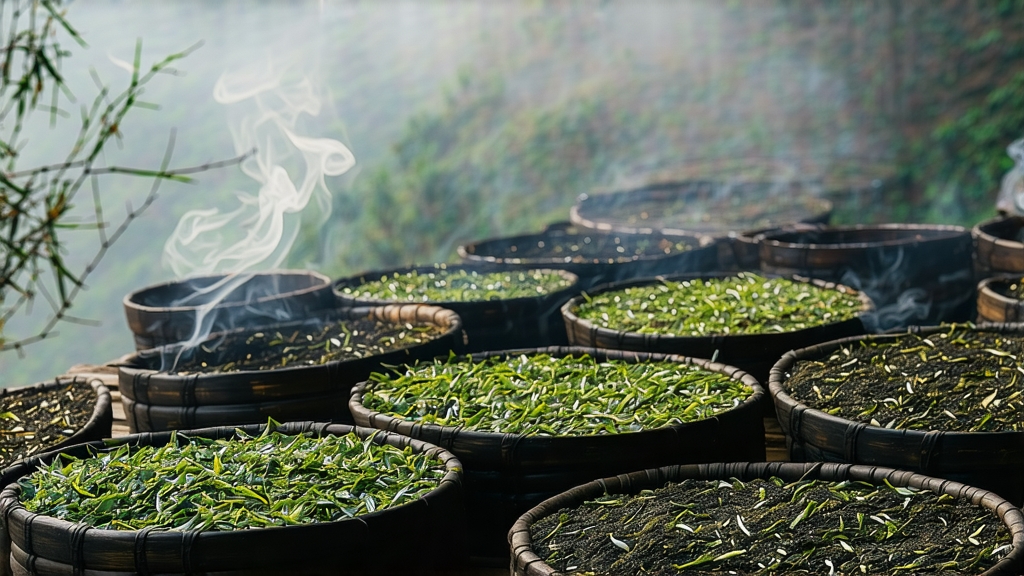
Long before English tea clippers raced across the oceans and Victorian drawing rooms echoed with the clink of porcelain, a small village deep in China’s Wuyi Mountains was already perfecting the art of black tea. Today that village—Tongmu—still sends the scent of smoldering pine into the fog-laden air, and the tea it produces, Lapsang Souchong, remains the oldest documented black tea on earth. To understand Lapsang Souchong is to hold a living fragment of global history: the moment when Chinese green-tea craft pivoted into oxidation, when maritime trade routes shifted, and when the very word “bohea” entered the Western lexicon as shorthand for the finest teas money could buy.
Historical records kept by the Jianyang county annals place the birth of Lapsang Souchong around 1568, late in the Ming dynasty. Legend claims a passing army requisitioned the drying sheds of Tongmu tea farmers; in haste to meet market deadlines, the farmers dried freshly rolled leaves over available pinewood fires. The resulting liquor—redder, deeper, and infinitely more stable for transport than green tea—delighted the Dutch and later the British, who by the early 1600s were paying twice the price of top-grade green tea for what they called “smokey bohea.” By the Qing era, caravans left the Wuyi passes laden with chests stamped “Lapsang,” a Cantonese approximation of the place-name, while European tea auctions coined the term “Souchong” to denote the larger, late-picked leaves that yielded this novel black tea.
Strictly speaking, only leaf harvested within the 60 km² national-protection zone of Tongmu Guan can be called Zheng Shan Xiao Zhong—Original Mountain Small Sort—the protected geographical indication that separates authentic Lapsang from countless imitations. Within that micro-zone, two distinct styles survive. The traditional pine-smoked version, known in export markets as “Smoke Tea,” absorbs volatile phenols from a slow, 18-hour firing over resinous Masson pine and local cedar. A newer, unsmoked “craft” style, increasingly popular among Chinese gourmets, omits the final smoking stage, allowing the honeyed, longan-fruit character of the indigenous Xingcun Xiaoye cultivar to dominate. Both styles share the same plucking standard: one bud with two or three mature leaves, picked after the Qingming festival when amino acids have begun to convert into soluble sugars, giving the finished tea its innate sweetness.
Crafting Lapsang Souchong is a choreography of heat, humidity, and wood smoke that has changed little in four and a half centuries. Withering begins on bamboo racks set high inside narrow, two-story wooden sheds whose latticed walls invite mountain breezes. For the smoked style, a small, below-floor fire of pinewood slabs is lit at dusk; the rising smoke drifts through a perforated brick chamber, bathing the leaf in cool, aromatic currents rather than direct heat. This gentle desiccation continues for eight to ten hours, until the leaf’s moisture drops from 75 % to roughly 40 %. Next comes rolling, performed on cast-iron trays once powered by water wheels but now rotated by electric motors. The goal is to rupture cell walls without shredding the leaf, releasing oxidases that will trigger the coppery transformation unique to black tea. Oxidation itself occurs in deep cedar trays covered with wet cotton cloths; the tea master monitors temperature (26–28 °C) and ambient humidity (above 80 %) by touch and scent alone. When the leaf has achieved a uniform mahogany edge and the aroma shifts from grassy to dried apricot, the mass is quickly transferred to a 90 °C charcoal-heated wok for “killing the red,” a 3-minute pan-fire that halts enzymatic activity. The final smoking—or absence thereof—defines the tea’s ultimate personality. For traditional Lapsang, the same pinewood is now burned in a separate underground pit; the tea rests on sieves 1.5 m above the embers, absorbing phenolic compounds that will later read as campfire, resin, and winter spice. The process is repeated up to three times, each cycle lasting 20 minutes, with 2-hour rest intervals to allow moisture migration from stem to leaf.
Because Lapsang Souchong is both robust and nuanced, it rewards gongfu brewing as readily as Western-style pot infusions.